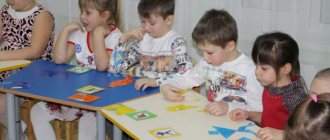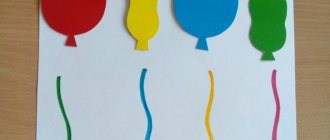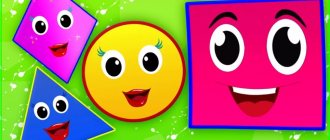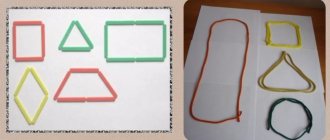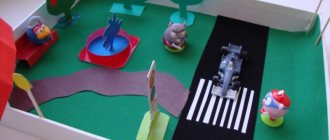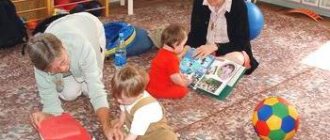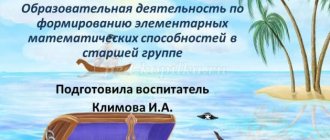Goals and objectives of texts for preschoolers of the junior, middle and senior groups
In the younger group, the teacher, with the help of mathematical fairy tales, introduces children to the simplest quantitative concepts, such as “many”, “one”, “none”. In ordinary fairy tales, he points to the shapes of objects associated with geometric figures. In the middle group, mathematical fairy tales are synthesized with folk tales that children already know well. Let's take Kolobok, for example. The teacher, while reading, will highlight the serial number of each “step” of Kolobok, thereby demonstrating how the main character moves step by step. And the fairy tale “Teremok” will help you count the number of heroes in the house. Between fairy tales, the teacher uses finger exercises, with the help of which numbers are studied.
Using fairy tales, we teach the meanings of geometric shapes and their names
The middle group has the following tasks:
- Learn to count to five.
- Master knowledge of quantitative and ordinal numbers, fractions and whole parts.
- Strengthen the ability to navigate in time.
- Strengthen the skill of recognizing geometric shapes.
- Train spatial orientation (the child’s awareness of directions: between, under, behind, in front, etc.).
In the older group (children 5–6 years old), mathematical concepts, be it zero or square, become the heroes of fairy tales. When introducing preschoolers to a fairy tale, the teacher should not forget to ensure that the children understand the plot and meaning of the story. Fascinating games related to logic, such as:
- selection of identical pairs;
- making a rectangle equal to the provided sample;
- determining which items are more numerous.
Games will help the child establish the idea of equality and integrity of numbers and things. The operations performed by children contribute to mental development, the development of skills to synthesize, analyze and compare data.
In the senior group, mathematical fairy tales are used to achieve the following goals:
- Learn to count to twenty, recognize the missing number and count backwards.
- Relate the number of things to a number.
- Understand the meaning of the following quantities: width, length, height, volume (capacity) and mass (weight).
- Be able to distinguish and understand complex geometric shapes: line segment, angle, polygon, three-dimensional shapes.
- Develop the ability to navigate by the clock, quickly determine the hour and pronounce it out loud.
- Be able to perform simple arithmetic operations.
- Develop the ability to replace the hero of a fairy tale with a certain object (“Rubik’s Cube” - pick up a cube).
- Remember the names of the days of the week and months and their order.
The kindergarten approves the curriculum for the year. It must comply with the documents:
- Constitution of the Russian Federation, art. 43, 72;
- Convention on the Rights of the Child (1989);
- Preschool education concept;
- SanPin 2.4.1.2660–10;
- Law of the Russian Federation “On Education” (as amended by Federal Law of January 13, 1996 No. 12 - Federal Law);
- Model regulations on a preschool educational institution, approved by Decree of the Government of the Russian Federation dated September 12, 2008. No. 666.
There is no clear indication of the skills that a child should have, but the Federal State Educational Standard for Preschool Education states:
The child... ... ...has basic understanding of living nature, natural science, mathematics, history, etc.; the child is capable of making his own decisions, relying on his knowledge and skills in various activities.
Ministry of Education and Science of the Russian Federation
Order 1155
At the request of parents, they can be provided with a kindergarten curriculum, which outlines all the skills that children are taught. Teachers will tell you how and in what form the training will take place and provide additional information.
In the preparatory group, fairy tales include tasks on simple mathematical operations (in two steps), logical operations and methods for solving them. It is important to introduce children to the standards of length measures: meters and centimeters, and to tell them in a fairytale form about money and its proper use. Before school, classes will begin that cover the basics of mathematics and a fairy tale will help you understand and master more complex information.
